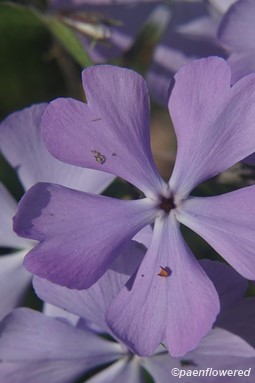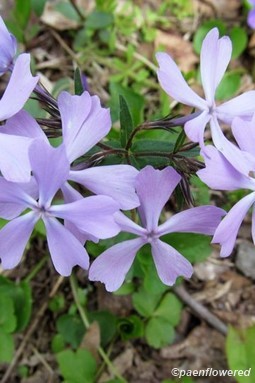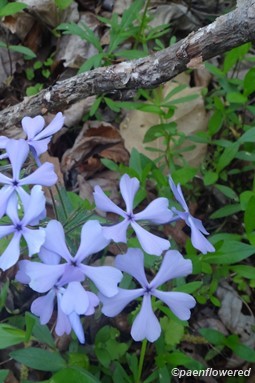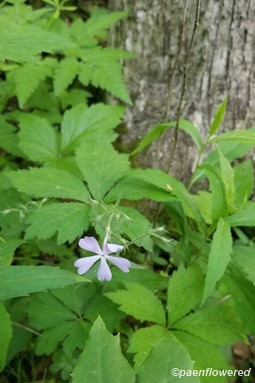Phlox divaricata
Forest wildflower with delicate, fragrant purplish-blue flowers
Phlox divaricata wild blue phlox
Add to MyPlants View Locations
Wild blue phlox is a native, semi-evergreen perennial that grows up to 18 inches tall. It produces both fertile and sterile shoots, with the sterile ones spreading horizontally and rooting at the nodes to help the plant form dense colonies.
Carpets of these pale blue flowers brighten the woodland floor when trees are just starting to put out new leaves. Clusters of delicate blue or violet blooms emerge from tips of sticky stems, each flower with five petal-like, notched lobes extending outward from a slender, tubular corolla - rather than true separate petals. The five stamens are positioned inside the corolla tube, rather than extending outward. This recessed arrangement ensures that pollinators like butterflies and moths must reach deep into the flower, increasing the likelihood of effective pollen transfer.
Wild phlox thrives in partial to full shade, preferring moist, well-drained soil rich in organic matter. It adapts well to woodland environments, where it benefits from dappled sunlight and natural leaf litter that enriches the soil. Once established, it can tolerate drier conditions, making it a good choice for shaded gardens and native plant landscapes.
Habitat & Range
Frequent in rich deciduous woods. Prefers partial to full shade and moist, well-drained soil rich in organic matter.
Mostly present in the west and south of the state.
Range: Native to eastern North America.
| EMP: | FACU |
|---|---|
| NCNE: | FACU |
Phenology
Flowers late April through early June.
Characteristics
Inflorescence rounded loose panicle of 8 to 25 flowers
Flowers pale blue to occasionally violet or white; corolla with 5 petal-like notched lobes and glabrous tube; calyx glandular pubescent with 5 light green to purple sepals; 5 stamens deep within the corolla tube
Leaves semi-evergreen, opposite, sessile, entire, lanceolate to elliptic; pubescent and sticky near stem; abt 2½″ long & ¾″ wide
Stem light green to reddish brown, terete, pubescent; sticky from glandular hairs; fertile and sterile shoots, sterile shoots decumbent forming roots at nodes
Fruit dehiscent ovoid 3-valved capsule, 1 to 4 seeds per locule
Height 9 to 18 inches
Plant Codes
S-rank: S5 (Secure)
G-rank: G5 (Secure)
Ecology
Main pollinators are bumblebees, bee flies, butterflies, skippers, and moths.
Roots can provide food for small herbivores like voles and rabbits.
Phlox divaricata wild blue phlox
Synonyms: Phlox divaricata ssp. divaricataAdd to MyPlants View Locations










Comments
Have you spotted this plant in your area? We'd love to hear about your experience! Share your comments or questions about the plant below. Comments are moderated before posting.